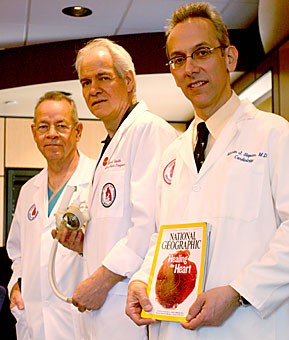An artificial heart developed at the UA that has been used worldwide is being featured on the February issue of National Geographic magazine.
The Total Artificial Heart is the only temporary artificial heart in the world, said Don Isaacs, director of communications for SynCardia Systems Inc., the company that manufactures the heart.
The heart has been implanted in 600 patients worldwide, from the Tucson University Medical Center to the Heart and Diabetes Center in Bad Oeynhausen, Germany.
“”If a heart transplant is not available, the artificial heart is a means to save someone’s life,”” said Dr. Marvin J. Slepian, a clinical professor of medicine and co-founder and chairman of the board for SynCardia Systems.
The heart was approved by the FDA soon after research was published in the New England Journal of
We went from a science project to a therapeutic reality.
– Dr. Marvin J. Slepian, clinical professor of medicine
Medicine in 2004. In early 2005, training began for different heart centers around the world.
“”We went from a science project to a therapeutic reality,”” Slepian said. “”Now it is widely available to specific centers that do heart transplants.””
Now that the heart has made the cover of National Geographic, awareness will expand beyond the medical and science communities, Slepian said. The article “”emphasizes the worldwide recognition of the importance of this technology,”” he said.
The main use for the temporary heart is to prevent the body from shutting down because both sides of the heart are no longer pumping enough blood to give nutrition to the kidney and liver, Isaacs said.
“”The article tracks the implementation of the artificial heart and tracks the patient afterwards,”” Slepian said.
SynCardia Systems is looking to have the temporary artificial heart available at the 200 largest heart transplant hospitals in the world. Currently only 20 centers provide the transplant, but there are plans to increase the number to 34 by the end of 2007, Isaacs said.
On the road to today’s success of the temporary artificial heart, there were obstacles in the process.
“”In the late ’90s there were many hospitals under pressure to cut programs that weren’t tied to medical care,”” Isaacs said. “”But Dr. Slepian, who worked with Dr. (Jack) Copeland and bioengineer Richard Smith, put together a fund from private investments that provided the money to study the heart and to keep the company going.””
Since then, the temporary artificial heart continued to progress through clinical trials to finally reach approval.
Recognition for the CardioWest Total Artificial Heart continues today as the original design of the heart will be presented to the Smithsonian Museum.
“”It is very nice to see the recognition, as it emphasizes the ‘here and now’ of the technology that can help people,”” Slepian said.









